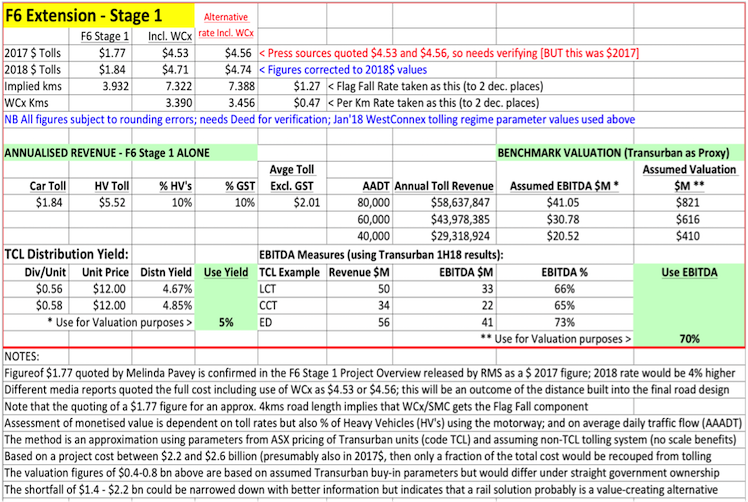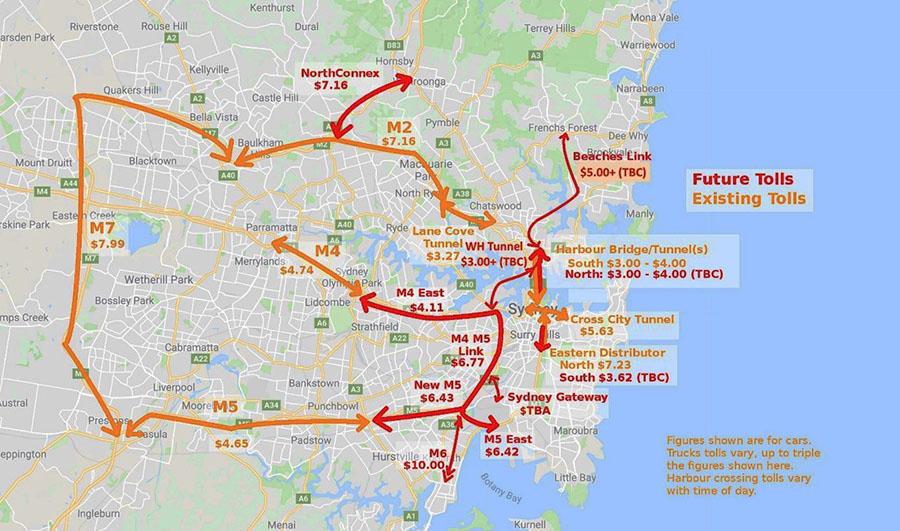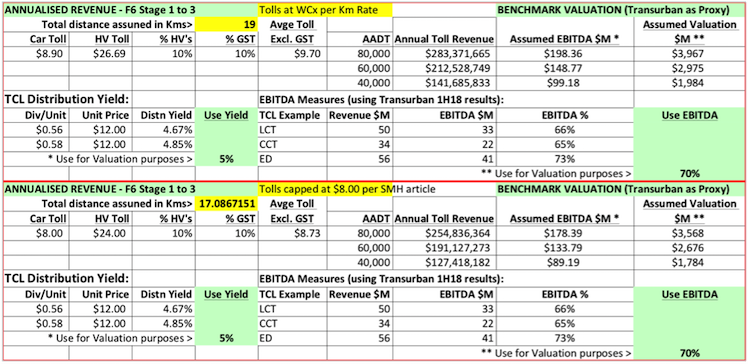The WestConnex project in Sydney has generated massive opposition form affected communities and led to the rise of community groups that are waging an ongoing campaign. This battle has contributed to the growth of a lack of confidence in government. This article by Michael West (18 June 2018) provides a rundown of the latest developments, which includes the moves to sell the project’s resulting tollways to the private sector.
It is little wonder that trust in government is bruised by the day. The secrecy and dissembling over Australia’s largest infrastructure project, WestConnex, is a case in point.
To be fair, some sympathy might be conceded governments undertaking ambitious public works projects, especially when they entail tearing down peoples homes to build motorways and locking horns with angry residents’ groups. Even from the outset however, the $17 billion WestConnex project in Sydney has been handled more like an SAS mission than a public project requiring community consent and deliberation. As a suite of project deadlines looms, public confidence is running low.
The greatest flaw in this project has perhaps been the failure to consider, from the start, whether rail might have been a better option than road. There was no “Public Sector Comparator” to contemplate a mass transit alternative which might be cheaper and more efficient. No public consultation or discussion. Just roads to be privatised, tolls to be had to juice up the sale price from privatisation.
Now, as the deadline for sale nears, the sale that is of a 51 per cent majority stake in Sydney Motorways Corporation (SMC) which houses the gargantuan WestConnex, questions over the project are hitting fever pitch. Does it stack up?
The latest concerns:
- A report about the F6 extension exposing the government for misleading information on tolls.
- Reports of Cimic withdrawing and the bidding race now a duel between the Transurban and the Industry Funds consortia.
- Still no clarity on the “equalisation” scheme which artificially increases the length of toll roads and therefore lifts toll prices by stealth.
- Reports of a half a billion dollar cost blow-out on the new M5.
- An apparent cover-up of data relating to dangerous air pollution at a St Peters school.
Last Tuesday, NSW Premier Gladys Berejiklian, flanked by Treasurer Dominic Perrottet and Minister for Roads Melinda Pavey unveiled plans for the twin four-kilometre tunnels they said would “connect the new M5 Motorway at Arncliffe to President Avenue at Kogara” and “allow drivers to bypass 23 sets of traffic lights and save up to 15 minutes on each journey”.
The Premier proceeded to say this F6 Extension (note it is not being called M6 yet despite the tolls announced) was now fully funded and open for community feedback. The poor old “community” had better be quick. Deadline is July 27.
It is all compressing in time as the Australian Financial Review reports that final bids for the transaction to sell 51 per cent or more of Sydney Motorway Corporation are due just four days after competition regulator, Australian Competition and Consumer Commission (ACCC) has said it will announce its decision on competition aspects such as the bid by monopoly toll-road operator, Transurban.
The timetable:
- July 19: ACCC decision,
- July 23: final bids,
- July 27: public feedback on F6,
- March 2019: NSW election.
The sequence is telling in itself, with the public bringing up the rear, vis-a-vis the ACCC and the final bids, and then the spectre of a partial announcement closer to the state election early next year which could leave voters uninformed as to the detail of the transactions. The NSW Treasury website still lists the transaction timing as “targeted to close in mid-2018”.
“That seems to be a clear way to get the deal through without having to listen too much to the public, particularly the many anti-WestConnex groups and those calling for public transport solutions to take priority,” says Ian Bell, a transport expert whose actuarial firm has analysed WestConnex.
“It also means banking some financial commitments sufficiently before the March 19 state election such that things can’t be over-turned. And that is regardless of what happens with the design of the controversial Rozelle “spaghetti interchange”, says Bell. “But the awarding of a winning bid before that design being fixed might clarify some aspects of the vexed issue.”
What would be a good outcome for the state? How much will the bidders pay? As there are no details as to future patronage, debt, and even what assets are being sold into SMC, it’s a pure stab in the dark.
The most likely outcome is the revelation later this year of a fancy headline number to maximise the Government’s prospects of re-election. In keeping with the secrecy of the entire WestConnex process, such a number will be manufactured to be as large as possible. It is likely to include debt and conditional payments over a number of years.
Could there be debt forgiven SMC? Perhaps. Vendor finance? Perhaps. The attractive aspect of the structure, on the face of it, is that as the state is slated to retain a 49 per cent minority stake in SMC, it has “skin in the game” if the toll-roads perform well. Its interests appear to be, and ought to be, aligned with the interests of the buyers – risk and reward.
To have this “stab in the dark” then; the projected cost of the project which still remains at $16.8 billion – and is looking decidedly optimistic – so if the Government of Gladys Berejiklian could do a deal which somehow valued SMC at close to $20 billion, it could claim to have (at least at some point if everything went swimmingly) delivered a key infrastructure below cost.
The reality might be that actual cash input from the victorious bidder, IFM or Transurban, might only be around the $5 billion mark. In any case, this is pure speculation because we still don’t know what assets are going to be included for sale. No doubt any announcement will be cunningly crafted and accompanied by a narrative of cash rolling into the state coffers to be spent on future projects to benefit the people of NSW.
As to public consultation, residents in Sydney’s south may well ask if there is any point in expressing a view on the F6 deal.
“What we can say is that the $1.77 car toll rate announced by (roads minister Melinda) Ms Pavey certainly won’t pay much of the projected cost of $2.2 million to $2.6 million (excluding that already built into WestConnex Stage 3).”
Ian Bell has supplied michaelwest.com.au with a brief benchmarking analysis which he and colleague Leo Economides put together using publicly available information about Transurban’s pricing which can be found in Australian Securities Exchange (ASX) filing.
They model the likely annual toll revenues, net of GST, and apply a method comparable to that of a real estate valuer “capping up” net passing current rent to estimate property capital values. The net toll revenues are converted to an estimated or assumed EBITDA (earnings before interest, tax and depreciation/amortisation) then capitalised by dividing by Transurban’s forward distribution yield.
 Bell and Economides found the quoted toll rate of $1.77 for the F6 extension to/from Kogarah is, as has since been admitted, as not able to be availed of by drivers without them also using the new M5 part of WestConnex. Good for the bidders, and good for the owners of the Eastern Distributor, not so good for captive motorists.
Bell and Economides found the quoted toll rate of $1.77 for the F6 extension to/from Kogarah is, as has since been admitted, as not able to be availed of by drivers without them also using the new M5 part of WestConnex. Good for the bidders, and good for the owners of the Eastern Distributor, not so good for captive motorists.
Moreover the $1.77 and the confusing reports of $4.53 or alternatively $4.56 for the full ‘no-way out’ trip to or from the St Peters interchange of the New M5 section, are in 2017 dollars.
As we are now half way through 2018, Bell has added another four per cent to include the annual WestConnex toll uplift.
Bell has shown in the following table the high and low values his method gives for the amount of subsidisation going into this project: anywhere from $1.4 billion to $2.3 billion.
To summarise:
- The level of subsidisation in this deal seems to be a very high proportion of its claimed project costs.
- At this level, the burning question of whether a rail solution would have been superior to road is even more pertinent.
“For example, a tunnel between Sutherland and Kogarah to provide express train services, thereby improving the commuting times for both Cronulla-Sutherland workers and those from the Illawarra by an estimated 14-15 minutes, might make a huge difference to commuting comgestion,” says Bell.
Based on the $1.15 billion for the Thiess-John Holland-Dragados Joint Venture on North West Metro twin 15k rail tunnels and station works, maybe about $1 billion would be enough. “For some unknown reason the government has rejected the idea of studying such (rail) ideas in detail.
Rail the best solution
In the Federal Faster Rail EOI process last December, the Sydney FastRail Consortium put forward a two tunnel solution (the second tunnel being Thirroul-Helensburgh, a partial solution much discussed over the years) to bring transit from Wollongong to Central down from a current 90 minutes to around 45 minutes, with their provisional cost estimate for a two-bypass solution being around $3.5 billion.
So far, says Ian Bell, the state infrastructure bureaucracy has refused or omitted to seriously study rail solutions. “How would the public know that Transport for NSW has decided the best strategy for this corridor if we simply do not know if any other alternatives have been considered?”
Instead, it seems what the public will get is Stage 1 of F6, which will fill up over time, then Stage 2 and Stage 3, and apparently all before properly addressing possible augmentation of public transport in a way which takes enough cars off the roads such that such expensive increased motorway provision is no longer really necessary.
Going further ahead in time, consider what the outcome might be from completing stages 2 AND 3 of this F6 Extension project. Sparse data is available but press reports suggest it is 19 kms long from the New M5 at Arncliffe to Loftus and will have a toll capped at $8.00, which seems to be a little less than the full WestConnex per km rates, which would make it $8.90.
Again Bell & Economides have used the “Transurban proxy method” of valuation, simplistic though it is, and the Sydney Morning Herald’s article, which put the project cost at $9 billion (and which probably also was in 2017 dollar terms).
As the table of results below shows, the subsidy versus private sector valuation seems to be between $5 billion and $7 billion; certainly enough to make alternative Illawarra rail line improvements give a superior benefit-cost outcome, perhaps even enough to justify a two-tunnel improvement to the Illawarra Line and a project start for the Maldon-Dombarton freight rail line or one of the other known proposals for combined freight and passenger links between the Illawarra and Western Sydney : namely University of Wollongong’s South West Illawarra Rail Link (SWIRL ) concept or Sydney FastRail’s higher speed version South West Illawarra Fast Train (SWIFT ).
Does Sydney keep adding new motorways and widening existing roads into the future until we replicate something like the story of Katy Freeway, Houston, Texas in the US? This is what Wikipedia says: “When constructed during the 1960s, the I-10 Katy from Houston, known as the Katy Freeway, was built with six to eight lanes wide barring side lanes, being modest by Houston standards because existing traffic demand to the farming area of West Houston was relatively low.
As the population and economic activity increased in the area, vehicular traffic increased, reaching an annual average daily traffic (AADT) of 238,000 vehicles in one part in 2001. Increased traffic levels and congestion In 2000 led to plans being approved for widening of the freeway to 16 lanes with a capacity for 200,000 cars per day. An old railway running along the north side of the freeway was demolished in 2002 in preparation for construction, which began in 2004 …and was completed in October 2008”, by which time there were 23 lanes. However, not so long after that the congestion returned.
The department, RMS, certainly seems to follow the theory that to continue to add road space will solve our congestion problems and they always seem to manage to crowd out needed extra investment in mass transport solutions.
So, when will the tipping point be reached?
The problem is that governments come and go and the bureaucracy either doesn’t learn or doesn’t care beyond the next election cycle, says Bell. There is enough evidence if one wants to look. For instance, the Sydney road speed story according to Fairfax Media analysis of RMS data.
The authorities keep playing catch up in trying to speed up traffic flows but they never seem to understand the principles, because politicians like cutting tape on projects and boasting that they are addressing a problem when in truth for the main part they are the problem. The SMH article from 2016 shows that trying to get road speeds up and travel times down is like a rat in a wheel cage.
The corollary of the Lewis-Mogridge position is the Down-Thomson paradox, which states that the equilibrium speed of car traffic on a road network is determined by the average door-to-door speed of equivalent journeys taken by mass/public transport.





Be the first to comment on "WestConnex sale looms as bidding duel narrows to Transurban, industry funds"